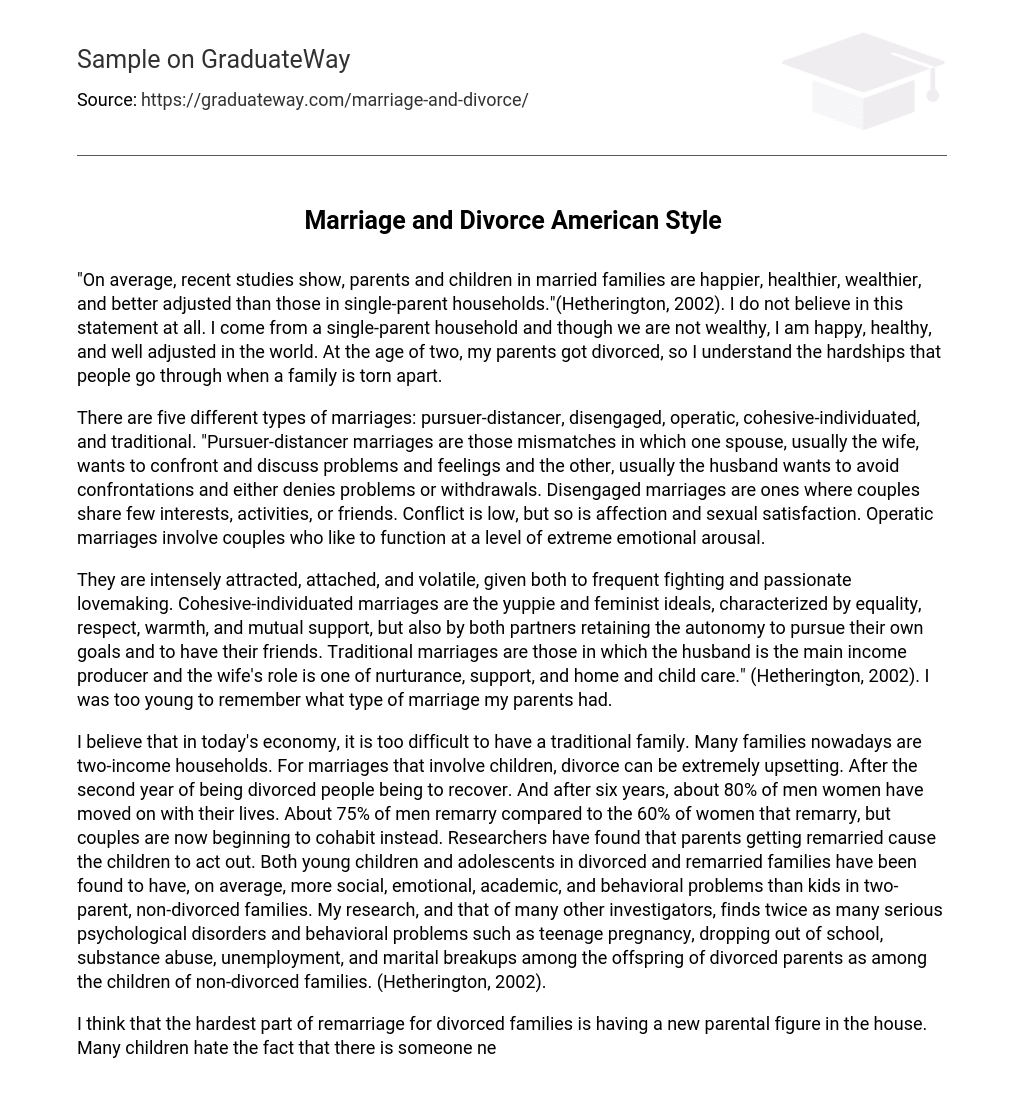“On average, recent studies show, parents and children in married families are happier, healthier, wealthier, and better adjusted than those in single-parent households.”(Hetherington, 2002). I do not believe in this statement at all. I come from a single-parent household and though we are not wealthy, I am happy, healthy, and well adjusted in the world. At the age of two, my parents got divorced, so I understand the hardships that people go through when a family is torn apart.
There are five different types of marriages: pursuer-distancer, disengaged, operatic, cohesive-individuated, and traditional. “Pursuer-distancer marriages are those mismatches in which one spouse, usually the wife, wants to confront and discuss problems and feelings and the other, usually the husband wants to avoid confrontations and either denies problems or withdrawals. Disengaged marriages are ones where couples share few interests, activities, or friends. Conflict is low, but so is affection and sexual satisfaction. Operatic marriages involve couples who like to function at a level of extreme emotional arousal.
They are intensely attracted, attached, and volatile, given both to frequent fighting and passionate lovemaking. Cohesive-individuated marriages are the yuppie and feminist ideals, characterized by equality, respect, warmth, and mutual support, but also by both partners retaining the autonomy to pursue their own goals and to have their friends. Traditional marriages are those in which the husband is the main income producer and the wife’s role is one of nurturance, support, and home and child care.” (Hetherington, 2002). I was too young to remember what type of marriage my parents had.
I believe that in today’s economy, it is too difficult to have a traditional family. Many families nowadays are two-income households. For marriages that involve children, divorce can be extremely upsetting. After the second year of being divorced people being to recover. And after six years, about 80% of men women have moved on with their lives. About 75% of men remarry compared to the 60% of women that remarry, but couples are now beginning to cohabit instead. Researchers have found that parents getting remarried cause the children to act out. Both young children and adolescents in divorced and remarried families have been found to have, on average, more social, emotional, academic, and behavioral problems than kids in two-parent, non-divorced families. My research, and that of many other investigators, finds twice as many serious psychological disorders and behavioral problems such as teenage pregnancy, dropping out of school, substance abuse, unemployment, and marital breakups among the offspring of divorced parents as among the children of non-divorced families. (Hetherington, 2002).
I think that the hardest part of remarriage for divorced families is having a new parental figure in the house. Many children hate the fact that there is someone new in their parents’ life because they want their parents to be together. I went back and forth with my stepmom for years. We have only gotten along for only 6 years out of the 18 years that my dad has been married to her. When I was younger I liked her because she use to buy me things all the time, but when I found out that she was the reason my parents split up I began to hate her.
I would always tell her that she cannot tell me what to do because she was not my mother. I remember one day during lent she told me I was going to hell because I was eating a piece of chicken. I so agreed with her that I told her that she was going to hell for committing adultery. I feel bad for the things that I have said to her in the past and everything is better with us now that I am older.
Bibliography
- Hetherington, E. Mavis. (2002). Marriage and Divorce American Style. The American Prospect, 62-63





